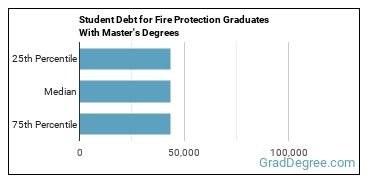Master’s Degrees in Fire Protection
Featured schools near , edit
Education Levels of Fire Protection Majors
During the most recent year for which data is available, 147 people earned their master's degree in fire protection. This earns it the #219 spot on the list of the most popular master's degree programs in the nation.
The following table shows the number of diplomas awarded in fire protection at each degree level.
| Education Level | Number of Grads |
|---|---|
| Master’s Degree | 147 |
| Graduate Certificate | 11 |
| Doctor’s Degree | 3 |
Earnings of Fire Protection Majors With Master’s Degrees
The median salary for graduates holding a master's degree in fire protection is $49,079. However, this can depend on a number of factors, such as where you live and the number of years experience you have. A better approximation of salary is to look at the typical range of salaries. In this case the low is $49,079 and the high is $49,079.

Student Debt
The median student debt for graduates holding a master's degree in fire protection is $36,322. The length of time it takes you to graduate and what college you attend can affect this number quite a bit. The chart below shows the range of accumulated debt loads. On the high side of the range, $36,322 is the debt load, and the debt load on the low side is $36,322.

Student Diversity
More men than women pursue master's degrees in fire protection. About 66.7% of graduates in this field are male.
| Gender | Number of Grads |
|---|---|
| Men | 98 |
| Women | 49 |

The racial-ethnic distribution of fire protection master’s degree students is as follows:
| Race/Ethnicity | Number of Grads |
|---|---|
| Asian | 0 |
| Black or African American | 19 |
| Hispanic or Latino | 12 |
| White | 101 |
| International Students | 5 |
| Other Races/Ethnicities | 10 |

Most Popular Fire Protection Programs for Master’s Degrees
There are 8 colleges that offer a master’s degree in fire protection. Learn more about the most popular 8 below:
The 2nd most popular school in the country for fire protection majors who are seeking their master's degree is Southern Illinois University Carbondale. Roughly 11,300 attend the school each year. The average in-state tuition for full-time undergraduates is $9,638 per year, while in-state graduate students, on average, pay $11,268 per year. During the most recent year for which we have data, 19 people received their master's degree in fire protection from SIUC. Around 16% of these students were from an underrepresented racial-ethnic group, and 20% were women.
California Polytechnic State University - San Luis Obispo is the 3rd most popular school in the nation for students seeking a master's degree in fire protection. Roughly 22,400 attend the school each year. The average in-state tuition for full-time undergraduates is $5,742 per year, while in-state graduate students, on average, pay $7,176 per year. During the most recent year for which we have data, 16 people received their master's degree in fire protection from Cal Poly San Luis Obispo. About 20% of this group were women, and 10% were students from an underrepresented racial-ethnic group.
University of Florida comes in at #4 on our list of the most popular colleges offering master's degrees in fire protection. Each year, around 53,300 students seeking various degrees attend the university. The average in-state tuition for full-time undergraduates is $4,477 per year, while in-state graduate students, on average, pay $10,770 per year. During the most recent year for which we have data, 13 people received their master's degree in fire protection from UF.
Oklahoma State University - Main Campus comes in at #4 on our list of the most popular colleges offering master's degrees in fire protection. Each year, around 24,500 students seeking various degrees attend the university. The average in-state tuition for full-time undergraduates is $5,417 per year, while in-state graduate students, on average, pay $5,611 per year. During the most recent year for which we have data, 13 people received their master's degree in fire protection from OSU.
University of New Haven is the 6th most popular school in the nation for students seeking a master's degree in fire protection. Each year, around 6,900 students seeking various degrees attend the university. The average in-state tuition for full-time undergraduates is $42,610 per year, while in-state graduate students, on average, pay $18,360 per year. During the most recent year for which we have data, 3 people received their master's degree in fire protection from University of New Haven.
Fire Protection Concentrations
| Major | Annual Degrees Awarded |
|---|---|
| 125 | |
| 10 | |
| 8 | |
| 4 |
Explore Major by State
Alabama
Arkansas
Connecticut
Florida
Idaho
Iowa
Louisiana
Massachusetts
Mississippi
Nebraska
New Jersey
North Carolina
Oklahoma
Rhode Island
Tennessee
Vermont
West Virginia
Related Majors
Below are some popular majors that are similar to fire protection that offer master’s degrees.
| Major | Annual Degrees Awarded |
|---|---|
| 7,387 | |
| 2,049 | |
| 1,771 | |
| 435 |
References
*The racial-ethnic minority student count is calculated by taking the total number of students and subtracting white students, international students, and students whose race/ethnicity was unknown. This number is then divided by the total number of students at the school to obtain the percentage of racial-ethnic minorities.
More about our data sources and methodologies.
Featured Schools
 Request Info
Request Info
|
Southern New Hampshire University You have goals. Southern New Hampshire University can help you get there. Whether you need a bachelor's degree to get into a career or want a master's degree to move up in your current career, SNHU has an online program for you. Find your degree from over 200 online programs. Learn More > |





